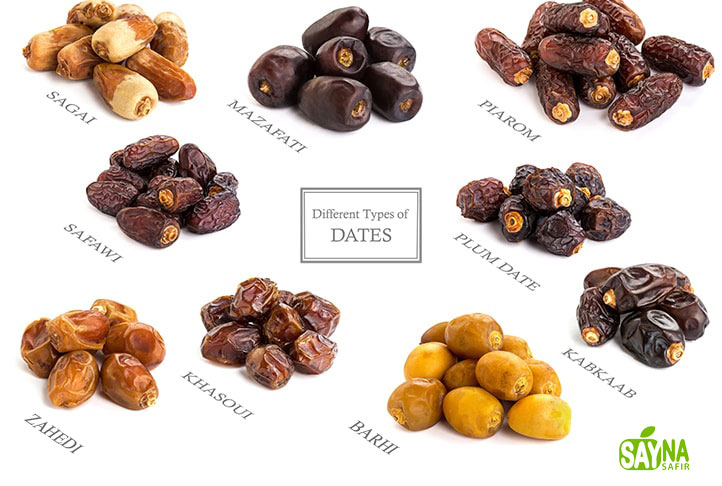Dates are such a holy fruit in the Middle East, so much that the date palm is regarded as the “Tree of Life”. Historians believe that dates are one of the ancient fruits that their cultivation traces back to around 8,000 years ago. There are more than 200 varieties of dates with different shapes and flavors, however, all of them are the same in nutrition. In this article, we are going to introduce some of these different types of dates.
14 Popular Dates Varieties:
-
Medjool Dates
-
Piarom Dates
-
Deglet Noor Dates
-
Mazafati Dates
-
Barhi Dates
-
Rabbi Dates
-
Thoory Dates
-
Sayer Dates
-
Dayri Dates
-
Halawy Dates
-
Sukkari Dates
-
Khudri Dates
-
Zahedi Dates
-
Safawi Dates

1- Medjool Dates
Taste and texture: They are soft, delicious sweet dates with a rich taste and fibrous texture.
Color and size: They have a color of amber to reddish-brown and large to very large in size.
Uses: They are perfect for eating fresh due to their high moisture.
Origins: Medjool dates are grown in Morocco, Palestine, Jordan and Saudi Arabia and ripen early in the season.

2- Piarom Dates
Taste and texture: Piarom dates have a dark thin skin that is fully attached to their flesh. They have a unique sweet taste with the traits of toffee and caramel.
Color and size: They are semi-dry, long, thin, and oval in shape with a dark brown to black skin and 2 to 5 cm in size.
Uses: Due to their level of fructose, they are suitable for people with diabetes and blood pressure. You can stuff the pitted ones with nuts creating a delicate snack for your cozy evenings.
Origins: They are cultivated throughout Iran and the Middle East since ancient Mesopotamia 6,000 BC.

3- Deglet Noor Dates
Taste and texture: These semi-dry dates are sweet and delicate in flavor and are known for their aesthetic Date flavor.
Color and size: They are medium to large in size and their skins ripens from amber to a deep brown.
Uses: Deglet Noor dates are excellent for cooking and ripens late in the season. The name itself means “date of the light” because the center of the date looks golden or light when held up to the sun.
Origins: Not specific.

4- Mazafati Dates
Taste and texture: 15% to 35% moisture with a natural soft taste of caramel and chocolate with traits of brown sugar.
Color and size: They have an attractive soft and fleshy appearance with a dark brown color. The size of Mazafati dates usually ranges from 2.5 to 4 cm with a thick flesh.
Uses: Mazafati dates are loaded with vitamins, fiber and potassium. You can eat them right out of your bag as a snack. Pit and stuff them with cheese or whatever you desire.
Origins: These dates are originated from Bam, a city in Kerman, Iran.

5- Barhi Dates
Taste and texture: These dates are fresh, rich with a syrupy flavor.
Color and size: They are the smallest and most fragile type of dates. The firm skin and flesh turn amber, then golden brown when stored, and the fruit itself is small to medium in size.
Uses: They are suitable for using in the desserts, they tend to keep their texture and pair wonderfully with different fruits.
Origins: The Barhi palm was introduced to California in 1913 from Basra, Iraq.

6- Rabbi Dates
Taste and texture: Rabbi Dates have thin, meaty skin that clings to the flesh with a soft texture and have the best taste among dates; they are sweet, fleshy and soft with 3 to 5 cm size.
Color and size: They are semi-dry, long, oval-shaped dates with an attractive reddish black color, their size is available from 3 to 5 cm.
Uses: You can use them directly as a snack, or stuff or chop them to use in cereals, puddings, breads, cakes, ice creams and candy bars.
Origins: Rabbi Date is one of the oldest and most delicious dates cultivated in Iranshahr, Zabul, Chabahar and other cities in Sistan Baluchistan, Iran.

7- Thoory Dates
Taste and texture: They are fairy dry and have a delicate nutty flavor.
Color and size: The fruit is medium to large oblong in shape with golden-brown flesh and ripens late in the season.
Uses: These dates are called the bread date due to their perfect pairing with bakeries.
Origins: Thoory or Thuri is famous in Algeria.

8- Sayer Dates
Taste and texture: They are semi-dry dates with a unique soft texture and a sweet flavor.
Color and size: Sayer dates are long and oval and about 2.5 to 4 cm in size, they start off yellow in color and turn amber to reddish and dark brown as they ripen.
Uses: They are great for having a snack straight out of the pocket, you can also use them in sweet and savory dishes.
Origins: Sayer dates are originated from the Middle East and lands around the Persian Gulf like Iran.

9- Dayri Dates
Taste and texture: These soft dates are heavy and sweet in flavor.
Color and size: These fruits are medium to large and have soft flesh and red skin. When they ripen, the skin turns from red to amber, then to a golden brown when stored.
Uses: The sweet but not overly cloying rich flavor of the Dayri date makes it suitable for sweet and savory recipes. Its large size makes it ideal for a stuffing date that is elegantly complemented by salty bacon and rich, creamy goat cheese.
Origins: They are originated from Basra, Iraq.

10- Halawy Dates
Taste and texture: They are a delightful soft date with a sweet caramel-honey like flavor.
Color and size: Halawy is a small to medium fruit with golden-brown skin and flesh that is delicate and tender.
Uses: They are perfect for an afternoon snack to eat right out of your bag.
Origins: The Halawy date variety is from Mesopotamia, and the name literally means “Sweet” in Arabic.

11- Sukkary Dates
Taste and texture: A sweet crispy high-quality date considered to be both very nutritious and great for healing. The name of Sukkary is obtained from “Sukkur” which means Sugar in Arabic.
Color and size: Sukkary Dates are the Queen of Dates that are appreciated for their golden, light, melt-in-your-mouth goodness.
Uses: They are the perfect replacement to sweet treats. Moist with dessert-like sweetness and need to be soaked.
Origins: They are cultivated in Al Qassim region.

12- Khudri Dates
Taste and texture: They are moderately sweet with a nice “Date” flavor, chewy but not dry.
Color and size: These dates have a smooth dark brown color, not too wrinkly. Their skin flakes a little and comes in both small and large sizes
Uses: They are used as a delicious snack or sugar alternative.
Origins: They are cultivated in Egypt and Saudi Arabia.

13- Zahedi Dates
Taste and texture: They have a rich nutty flavor which is often reminiscent of peanut butter with a slight taste that brings dried apricots to mind.
Color and size: Zahidi dates are medium-sized and oval in shape. They have light brown skin and a thick, golden inner meat that encloses a single seed.
Uses: Consuming these dates can prevent many diseases such as indigestion, anemia while improving memory and vision.
Origins: Zahidi means “of a small quantity” or “nobility,” and was cultivated around the 1900s in Northern Iraq.

14- Safawi Dates
Taste and texture: Their sweetness and flavor are more intense than Khudri dates. Chewiness varies with how wrinkled the date is: a more wrinkled date is harder to chew.
Color and size: They are medium-sized round dates and have a dark black cherry color with hints of brown.
Uses: They are known best for treating anemia and intoxication. Safawi Dates improve digestion, too.
Origins: Safawi dates are light, moist, and delicious dates grown in Madinah, Saudi Arabia.

There are lots of different date varieties, but the above-mentioned 14 dates are the most popular ones. The others are:
Ajwa Dates, Ambera Dates, Dried Dates, Hayani Dates, Iteema Dates, Kalmi Dates, Khola Dates, Mabroom Dates, Maktoom Dates, Migraf Dates, Saghai Dates, Saidy Dates and Warehouse Dates.
They are, after all, the fruits of heaven, so it doesn’t matter what type you choose, you will be surprised with their benefits.
Ref: RatinKhosh

Leave a Reply